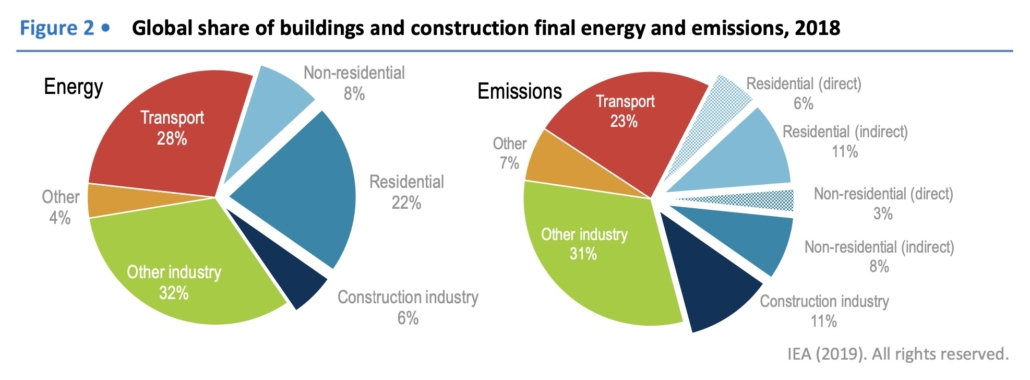In the buildings and construction sector accounted for 36% of final energy use and 39% of energy-related C02 emissions according to the IEA (2019) https://www.iea.org/reports/global-status-report-for-buildings-and-construction-2019. The global emissions are still rising and although the energy is increasingly from electricity, this is not provided by renewables, it is supplied by coal and gas. With increased urbanisation the demand for
heating and cooling is also increasing at an unsustainable rate causing more emissions. With building and construction emissions heavily intertwined it is imperative to look for more sustainable solutions for both. This is in the form of more efficient building construction and building materials. Also the reuse of building materials after the building is deemed of no-use anymore, demolition also highly contributes to global and UK emissions. This is the embodied carbon that is found in building products that can be restored. A paper on the Carbon Footprint of construction by Sizirici et al. (2021) https://doi.org/10.3390/ma14206094 suggests that the total C02 emission from the construction sector was 5.7 billion tonnes.
Plastic Contamination
There are a large number of contributors to this figure and one being the production and use of plastic and plastic piping. Plastic contaminants construction waste and is used extensively in packaging with very little recycling occurring, 9% according to PBC Today (2024) https://www.pbctoday.co.uk/news/energy-news/copper-sustainability-construction-industry/137734/ . Plastic as a sub-sector has an associated domestic production of 3 Mt C02 (BEIS, 2010).
Sustainable Copper
The choice of building materials is one way to reduce emissions as good recyclable and reclaimable products like copper which are reused many times, 65% of all copper ever mined is still in circulation. This is beneficial to C02 emissions in the UK as BEIS (2010) suggest that the construction industry can effect 47% of the total emissions in the UK. The choice of copper for transporting water is not only effective, safe and can easily be recycled at the end of life. In fact the copper scrap market is highly effective in recovering all of its product. Copper also does not leave contaminants within water such as micro plastic and other harmful pollutants. The life expectancy of copper is also longer (PBC Today, 2024) and it can be easily repaired and is less of a fire risk. CuSP (2024) https://www.cuspuk.com/ report that copper is infinitely recyclable and has a longer lifespan making it a real sustainable product for now and the future. Copper offers a tried and trusted solution for the construction industry to move to a more sustainable future.
Copper Sustainability Partnership (2024)


